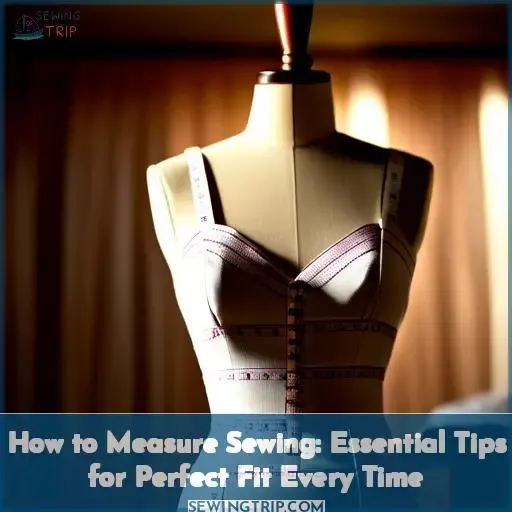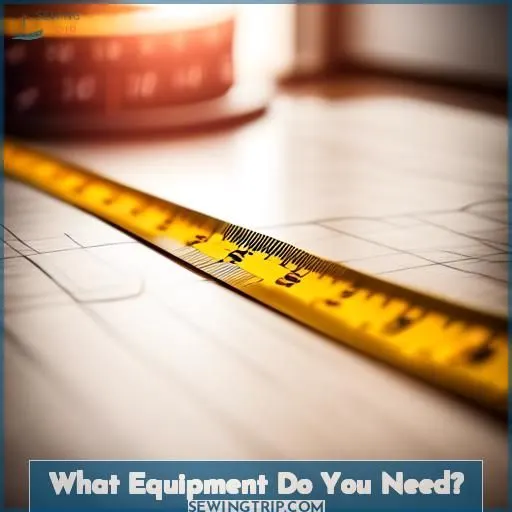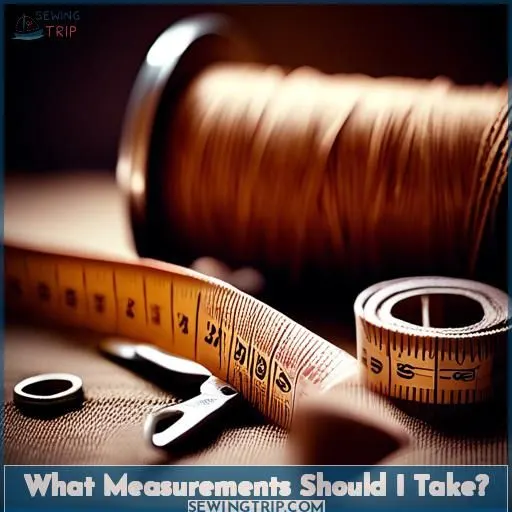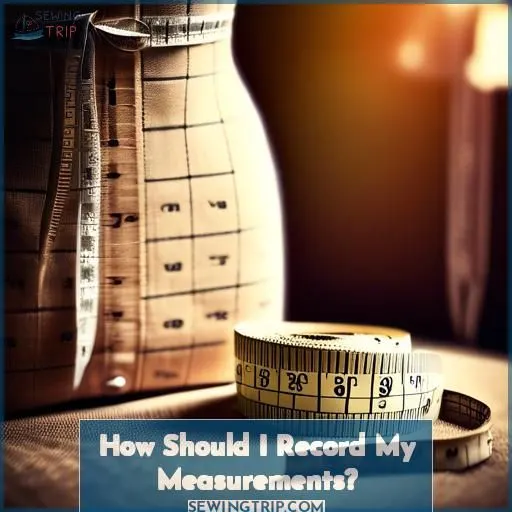This site is supported by our readers. We may earn a commission, at no cost to you, if you purchase through links.
To measure for sewing, you’ll need a measuring tape, mirror, good lighting, and fitted undergarments.
Stand upright, breathe normally, and hold the tape firm against your body.
Take bust, waist, hip, upper bust, and upper hip measurements.
Download a free body illustration, mark your measurements, and verify accuracy.
Choose the pattern size closest to your largest measurement, opting for a larger size if between sizes.
Adjust ease as needed.
Compare your measurements to the finished garment size for the perfect fit every time when learning how to measure sewing.
Table Of Contents
Key Takeaways
- To ensure accurate measurements for sewing, use a flexible measuring tape, stand in front of a full-length mirror in good lighting, and wear close-fitting undergarments.
- Key body parts to measure include the bust, waist, hips, upper bust, upper hip, neck, shoulder, arm, wrist, and front bodice, which are essential for selecting the right pattern size and achieving a perfect fit.
- Record your measurements by marking them on a free body illustration or using a measuring suit for a 3D image, and always double-check for accuracy to avoid errors in the final garment.
- Adjust the pattern size based on your largest measurement and consider ease allowance for a comfortable fit; compare your body measurements with the finished garment measurements and make necessary adjustments as you sew.
How to Measure Sewing?
To measure sewing, you need to follow these steps:
- Prepare and gather the right tools: Use a soft, flexible tape measure that is no wider than 1 cm and wear as few garments as possible while measuring. Ideally, only wear undergarments or close-fitting clothing to ensure accuracy.
- Take accurate measurements: Stand in a neutral position and avoid twisting or contorting your body while taking measurements. Measure from your natural waist to your ankle, adding a seam allowance for the hem.
- Record your measurements: Download a body illustration to mark your body measurements or use a measuring suit to get a 3D image of your body.
- Measure fabric: Use a tape measure that is accurate and measure a yard against another to ensure consistency.
- Calculate fabric yardage: For curtains, measure the width and height of the window, add the dimension from the bottom of the window to the floor, and add a few inches for fullness. For pillows, measure the length and width of the pillow or cushion.
What Equipment Do You Need?
Before embarking on the realm of sewing, you’ll require a few essential tools to guarantee your creations fit like a second skin.
Firstly, acquire a pliable measuring tape; it’s your newfound companion for capturing precise bodily measurements.
Secondly, situate yourself before a full-length mirror.
This purpose extends beyond vanity; it facilitates proper posture and ensures accurate measurements.
Thirdly, ensure adequate lighting.
No one desires to strain their eyes while interpreting minuscule numbers.
Finally, don close-fitting undergarments to prevent the addition of unnecessary bulk.
Therefore, prepare yourself and let’s commence the measuring endeavor!
Where Do I Start With Body Measurements?
To begin taking body measurements for sewing, you’ll need a few essential tools: a measuring tape, full-length mirror, and pen and paper for recording your measurements. Here are the steps to follow:
- Remove bulky clothing: Clothes can affect your body shape and measurements, so it’s best to measure yourself in your undergarments or tight-fitting clothes.
- Stand in front of a full-length mirror: This will help you see your body shape and guarantee accurate measurements.
- Hold the measuring tape firm against your body: The tape should be parallel to the body part you’re measuring.
- Breathe normally: Holding your breath can change your body shape, so breathe normally during the measurement process.
- Wiggle around to loosen your body: This helps guarantee that your body is in its natural shape when you take measurements.
Remember to double-check your measurements for accuracy to guarantee the best possible fit for your sewing projects.
What Measurements Should I Take?
To guarantee precise measurements for your sewing endeavors, it’s vital to identify which body parts to measure. Key measurements encompass the bust, waist, and hips, along with the upper bust, upper hip, neck, shoulder, arm, wrist, and front bodice. These measurements aid in determining the appropriate pattern size and ensuring an impeccable fit.
During measurement, employ suitable tools such as a pliable measuring tape, a cord or paper strip for belt measurements, and a ruler for length measurements. Always shed bulky attire, stand before a full-length mirror, and maintain the measuring tape firmly against your body.
When documenting your measurements, contemplate using a cost-free body illustration to mark your measurements, a measuring suit for a 3D image, or a size chart furnished by the pattern company. Remember to double-check your measurements for accuracy to avert any potential errors.
To select the correct pattern size, utilize the largest measurement (bust, waist, hips) to choose the pattern size. If your measurements hover between sizes, consider opting for a larger size and adjusting the ease allowance accordingly. Always juxtapose your finished garment measurements with your body measurements and adjust the pattern size if necessary.
Size charts and fitted measurements may vary between designers and countries, so it’s essential to consult the size chart and select the closest size to your measurements. If your body undergoes substantial changes, remeasure and adjust your pattern accordingly.
How Should I Record My Measurements?
To record your sewing measurements accurately, follow these steps:
- Download free body illustration: Use a body measurement app or download a free body illustration template to record your measurements.
- Choose body shape and print: Select a body shape that best represents your body type and print the template.
- Mark measurements on illustration: Once you have your body shape, mark all the essential measurements on the illustration, including bust, waist, and hip.
- Use measuring suit for 3D image and measurements: If you want a 3D image of your body measurements, use a measuring suit that provides a more precise representation of your body shape.
Remember to verify your measurements for accuracy to ensure the best possible fit for your sewing projects.
Frequently Asked Questions (FAQs)
How often should I take my measurements?
You should gauge yourself before initiating any fresh sewing endeavor, and remeasure periodically if your physique undergoes alterations. Even slight variations can substantially influence fit, so remain abreast of this. A garment that’s well-tailored? Invaluable.
What is the difference between body measurements and finished garment measurements?
You’re traversing the subtle boundary between your body’s curves and a garment’s fit. Measurements from your form encapsulate your essence, while final dimensions shape the fabric to accentuate your figure’s allure. Embrace both – one a private murmur, the other an artistic rendering.
How do I adjust the pattern size based on my measurements?
Compare your body measurements to the pattern’s finished measurements. Go up a size if you’re between sizes. If your bust is a larger size, cut the larger size and make a bust adjustment – sewing is all about customization. Trust the process; you’ve got this!
What is the purpose of ease allowance in sewing patterns?
Ease allowance is your sewing superhero, giving fabric room to breathe and preventing that dreaded sausage-casing look. It provides vital extra inches so your creations drape flawlessly over every curve. Finding that sweet spot? That’s the key to a professional, comfortable fit.
How do I check the fit of my garment as I sew?
You’re wise to check fit as you go. Sew basic seams first, then try it on. Make adjustments by trimming excess or recutting too-tight areas. Account for ease, seams, and darts – your garment should skim your curves comfortably.
Conclusion
Ultimately, are you prepared to reach the ideal fit when measuring for sewing? By adhering to these crucial tips and documenting precise measurements, you’ll gain the assurance to approach any sewing project with accuracy. Grasp the technique of how to measure sewing, and consistently flaunt garments custom-made to your distinctive proportions.











